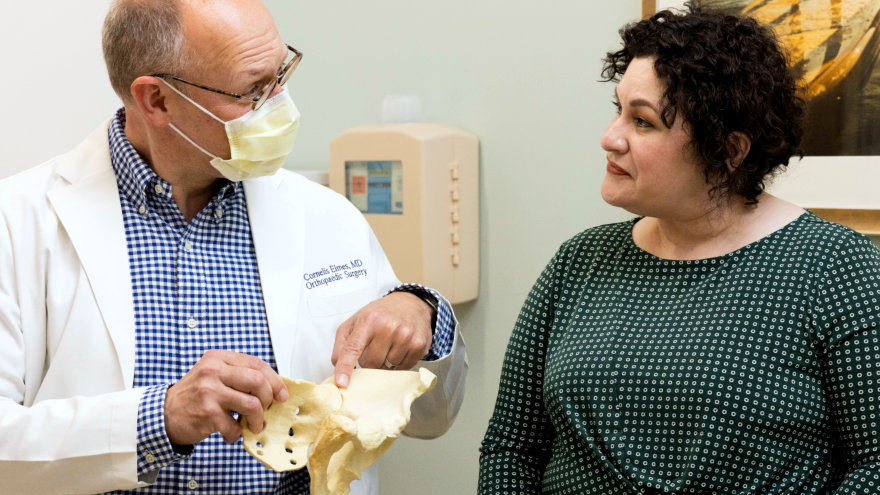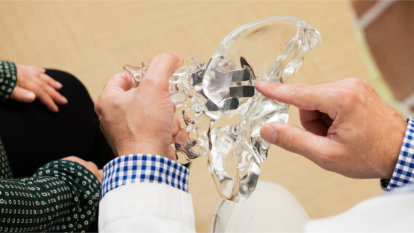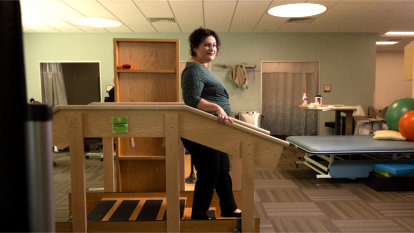
Getting Back to Normal
Fairfield resident Maria Murillo won’t have to worry about long car rides to see family this holiday season, or standing on her feet shopping, walking or other such activities.
For the past couple of years, those simple activities were impossible for Maria to endure without excruciating pain in her lower back.
Thanks to a minimally-invasive surgical procedure she had at NorthBay Health, that pain is long gone – in fact she recently enjoyed a long vacation in Colombia – and Maria says she couldn’t be happier with the outcome.
“I had lower back pain issues for years but then in 2020, I took a pretty slippery fall on concrete flooring and after that, the back pain got really bad,” she explained. “I tried adjustments, acupuncture, physical therapy for years, but nothing seemed to work.”
The pain got so bad, that she couldn’t lay on her right side, she couldn’t walk up stairs, drive or ride in a car for long periods or pick up her young nephew who likes to be held.
After seeing her regular doctor and specialists, it was determined that she had a problem with a sacroiliac (SI) joint. The SI joints link the iliac bones (hips) to the sacrum, or the lowest part of the spine above the tailbone.
In 15 to 30 percent of patients with chronic low back pain, the cause isn’t with their spine but rather with the SI joints. The joints are important because they act as shock absorbers for impacts from the lower extremities to the spine, for example, when running or lifting heavy objects. The joints don’t move as much as other joints in the body, but they move just enough to help diffuse some of the forces and decrease the risk of injury to the spine.
 Maria needed a surgery to fuse the joint on the right side of her body. SI joint fusion involves a small incision along the side of the buttock through which small triangle-shaped titanium implants are inserted across the sacroiliac joint. The implants, which are porous, encourage bone growth, which essentially fuses the joint so that it can no longer move, thus relieving the cause of the pain.
Maria needed a surgery to fuse the joint on the right side of her body. SI joint fusion involves a small incision along the side of the buttock through which small triangle-shaped titanium implants are inserted across the sacroiliac joint. The implants, which are porous, encourage bone growth, which essentially fuses the joint so that it can no longer move, thus relieving the cause of the pain.
Maria began researching the surgery and looking for surgeons who offer it and was excited to find NorthBay orthopedic specialist Cornelis Elmes, M.D.
However, when it came time to choose a surgeon, she listened to a friend who convinced her to try a Bay Area health provider. Then the COVID-19 pandemic hit, and many surgeries were delayed at health care organizations across the country. In addition, she had insurance approvals to win. So by the time she was able to get the surgery, her surgeon had left the area.
“But I remembered Dr. Elmes and now I feel like I should have just gone with him from the beginning,” she said. “He was very knowledgeable and when we first met in person, I had a lot of information but he gave me even more and I was very comfortable with him. He seems like a very chill doctor and I am very impressed.”
NorthBay Health Orthopedics offers several treatments to address SI joint pain, starting with physical therapy and exercises, especially those that help strengthen the body’s core muscles. Wearing a sacroiliac belt, or a device designed to limit movement of the joint, can help provide support for the area as well. For some patients, steroid injections in the area can provide relief for a short time, Dr. Elmes said.
When that’s not effective, interventional treatment such as a SI joint fusion is an option. In Maria’s case, prior treatments had little effect.
It is not uncommon for patients to undergo other treatment options or to have just endured the pain for years, not realizing the cause, said Dr. Elmes.
“Or they don’t have a problem until they fall,” he said. “Also, it’s common to think it’s low back pain, and even to have been told it’s back pain by a primary care physician in the past when it’s actually SI joint pain.”
Maria had the fusion surgery in March and says she is pain-free.
 “I am able to sleep on my right side, and just went for a long car drive with no issues,” she said. “I am so happy I got this surgery done. I’m very happy.”
“I am able to sleep on my right side, and just went for a long car drive with no issues,” she said. “I am so happy I got this surgery done. I’m very happy.”
SI joint fusion has proven effective in more than 90 percent of patients and because it is a minimally invasive procedure, recovery is faster. “Most patients find that after years of chronic pain, their pain is essentially gone within six weeks of the surgery,” said Dr. Elmes.
Fusing the SI joint does not limit a patient’s flexibility, and Maria can expect great long-term pain reduction. “The SI joint is not supposed to move much anyway,” he said.
“Studies are showing great outcomes with sustained pain relief and it should cure her (Maria) forever,” Dr. Elmes said. He added that in his experience, patients report their “pain is 95 percent better, often pain-free, with only certain activities that cause minor pain.”
Maria has advice to others who may be dealing with the same issues or contemplating the surgery: “Go for it. It’s worth getting it done,” she said.
Learn more about Dr. Elmes and our SI Joint services. To make an appointment with NorthBay Orthopedics, ask your primary physician for a referral.
